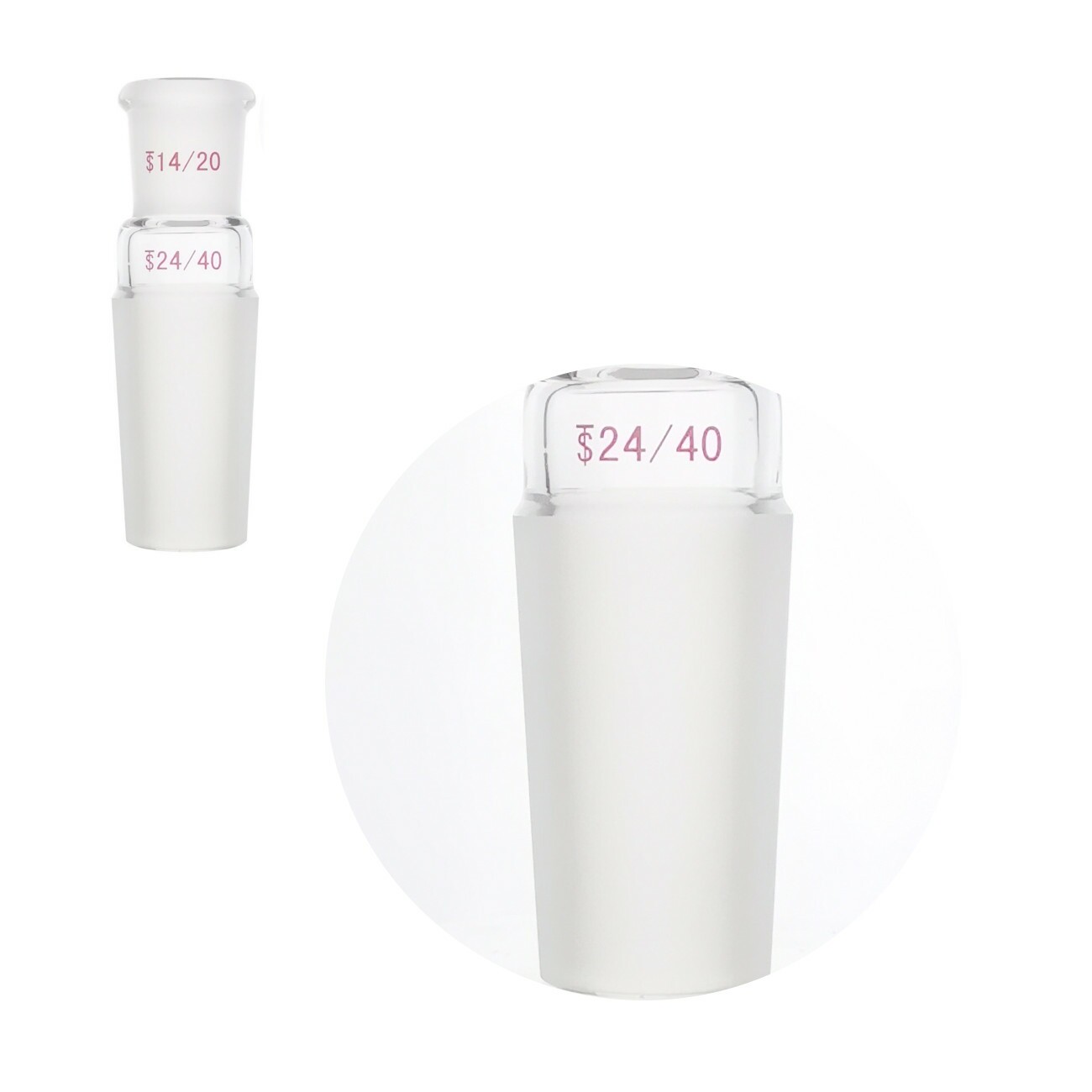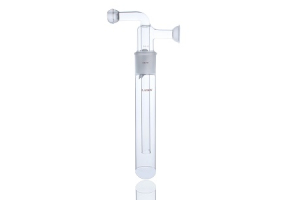In Organic Chemistry laboratories, ground glass joints are frequently used to assemble leak-tight apparatus which includes the parts made with interchangeable ground jointFor all the joints in standard taper glassware have been carefully ground so that they are exactly the same size ,and all the pieces fit together interchangeable.Every joint in the Laboyglass facility will go through three processes: two in the machine, then hand grinding to ensure leak-free operation.

Take a connecting adapter as example,the top 14/20 joint is an outer joint with the ground glass surface facing inward,we also call it a female joint.The lower 24/40 joint is an inner joint with the ground glass surface facing outward,we also call it a male joint. The 14/20 outer joint can accommodate an apparatus with 14/20 inner joint.The 24/40 inner joint can plug into an apparatus with a 24/40 outer joint.
But when we assemble an apparatus,we usually use the glassware with same size but different style( outer and inner) joint.For example,to assemble a simple distillation setup with 24/40 joints,

Two round bottom flasks(for distillation and receiving),a liebig condenser,a three-way thermometer adapter,a take-off adapter can be assembled quickly with the interchangeable joints.This is a significant advancement over prior methods such as custom-made glassware, which was time-consuming and costly, or the use of less chemically and heat-resistant corks or rubber bungs and glass tubes as joints, which also took time to prepare.
Two Joint Types
There are two general types of ground glass joints commonly used: joints :conically tapered and ball and socket joints (spherical joints).
The dimensions of taper joint in US and EU standard.
|
Joints in US standard |
Joints in EU standard |
|
ASTM E 676-02 (obsolete CS 21) |
ISO 383 (ISO K-6 series) |
|
10/18 |
10/19 |
|
12/18 |
12/21 |
|
14/20 |
14/23 |
|
19/22 |
19/26 |
|
24/40 |
24/29 |
|
29/42 |
29/32 |
|
34/45 |
34/35 |
|
40/50 |
40/38 |
|
45/50 |
45/40 |
|
50/50 |
50/42 |
|
55/50 |
55/44 |
|
60/50 |
60/46 |
|
71/60 |
71/51 |
|
|
85/55 |
|
103/60 |
100/60 |
Ground glass joints with a 1:10 taper are commonly labeled with a symbol consisting of a capital T placed over a capital S, which stands for "Standard Taper." This is followed by a number, a slash, and another number, such as 24/40. The first number is the outer diameter (OD) in millimeters (mm) of the inner joint at its widest point. The second value means the joint's ground glass length in millimeters.
Both standards have the same 1:10 taper and the same outside diameter at the joint top. The only difference is the joint length; for example, the 24/40 joint has an overall length of 40mm, but the 24/29 joint has a length of 29mm. As it is showed below ,they are interchangeable too.

Laboyglass only supply glassware in US standard,below is the detail dimension for the general size:

Ball and socket joint(spherical joint)
The inner joint of a ball-and-socket joint (also known as a spherical joint) is a ball, and the outer joint is a socket, with holes leading to the inner surface of their corresponding tube ends, to which they are joined. The ball tip is a hemisphere with a ground-glass surface on the outside that fits into the socket's ground-glass surface. This sort of joint separates easily and must be clamped together. A size number for ball-and-socket joints consists of a number, a slash, and another number. The first number indicates the ball's outer diameter in millimeters at its base or the inner diameter in millimeters at the socket's tip, in millimeters.The second number represents the inner diameter of the hole in the center of the ball or socket, which leads to the inner diameter of the tube connected to the joint.For example,the 35/20 socket/ball joint,the ball’s outer diameter at its base or the inner diameter at the sockets’ tip is 35mm,the inner diameter of the hole in the middle of the ball or socket is 20mm.

The picture above shows a socket (left) and ball (right) joints. By putting them together , they can be joined,a pinch clamp is required to fit them tightly.
Greasing ground glass joints
To ensure leak-free operation,the standard taper ground joints fit together tightly,they are often coated with a lubricating grease to prevent interaction of the ground glass joints with the chemicals used in the experiment that can cause the joints to stick together.It is not easy to take part stuck joints,in the article of “How to separate the stuck joints” lists several methods to separate the stuck joints.Even then,the standards taper glassware is frequently to be broken in this process.
There are several greases available.A hydrocarbon grease is preferred in an undergraduate laboratory,because it is easy to remove. Silicone greases also called vacuum grease,have a very low vapor pressure and are intended for sealing a system under vacuum.
A very thin PTFE sleeve which can be placed between the male and female joint is used to replace the grease to provide a good seal and prevents the joint from sticking, allowing the parts to be disassembled easily.

The PTFE sleeve, the common sizes are 14/20,19/22,24/40,29/42,45/50.
The glassware produced by laboyglass is all made with high-quality joints that are ground precisely to ensure adequate sealing. We had to put a piece of paper between the joints to prevent sticking with the new glassware components that were going to be assembled together.









